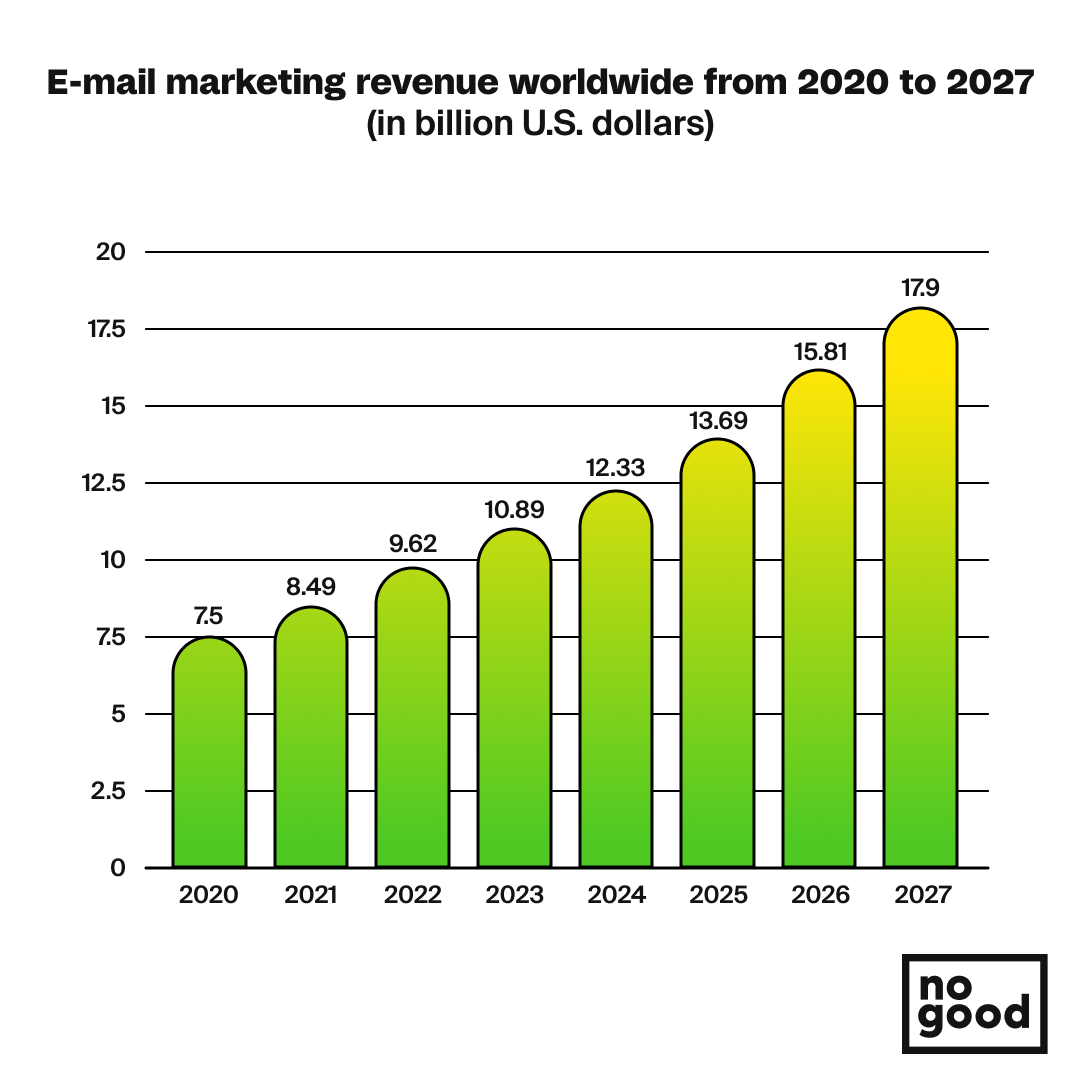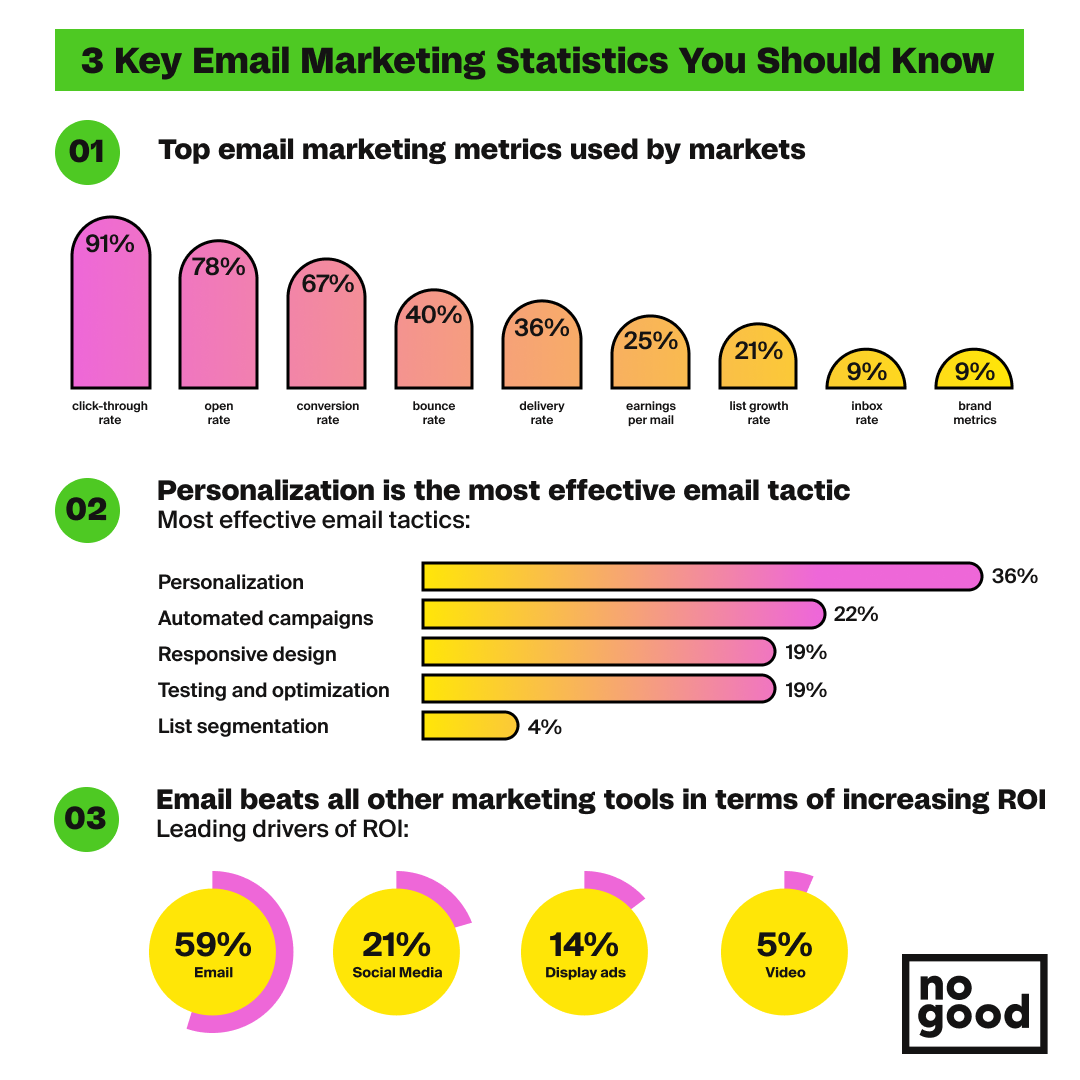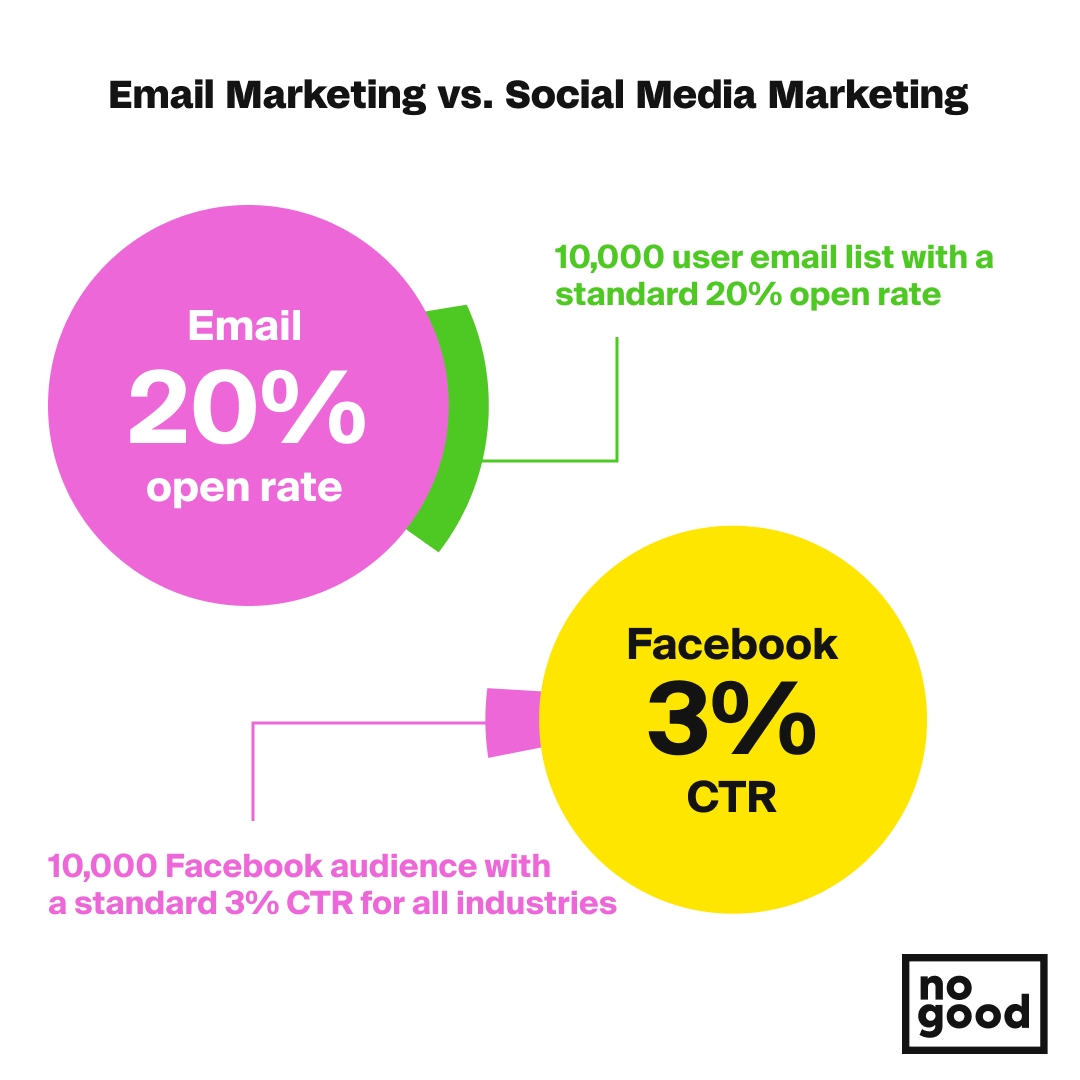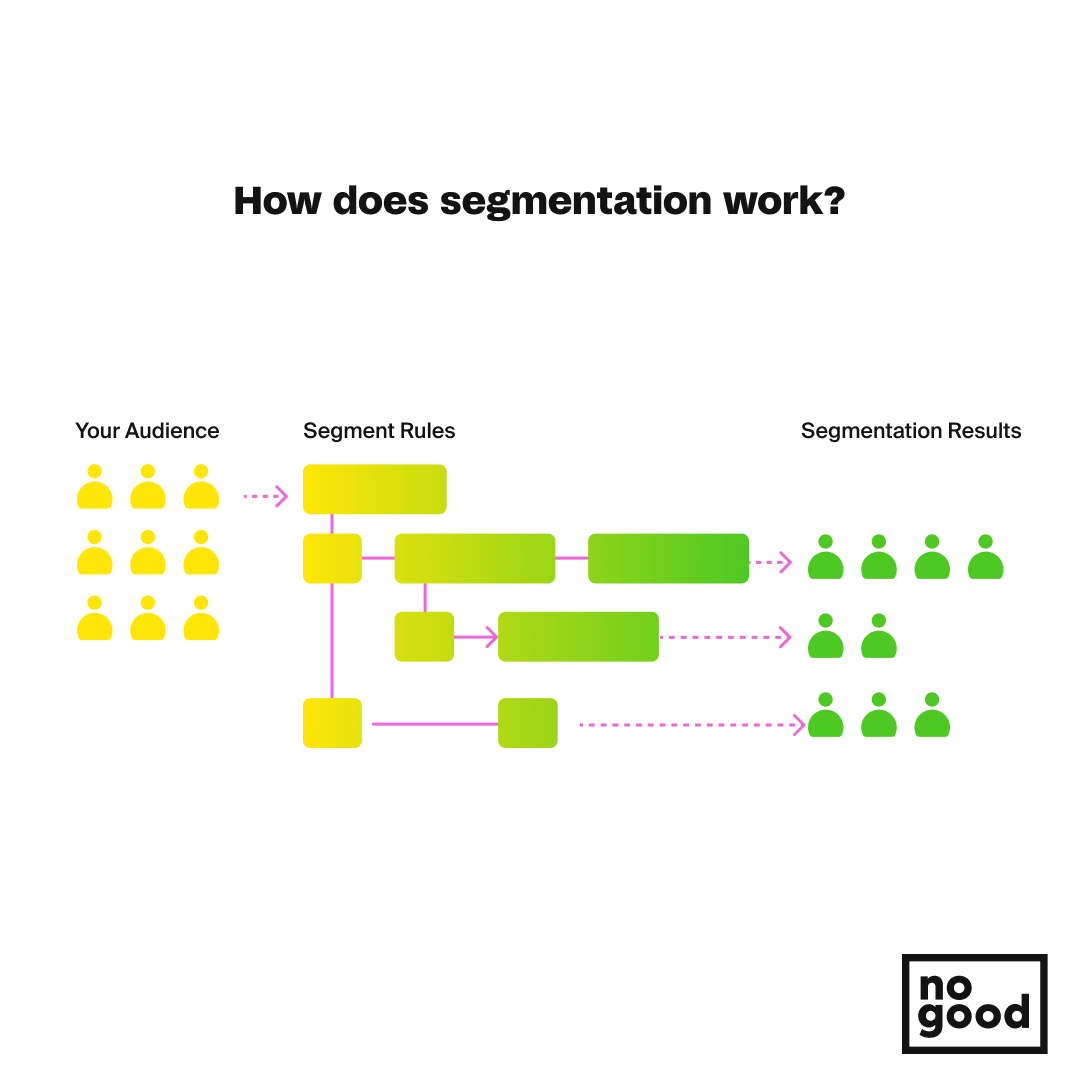What is email marketing?
Let’s get the most important question out of the way, what is email marketing? Email marketing, simply put, is marketing that is sent to potential or existing customers in your database. Historically, email marketing is one of the most successful marketing techniques you can use in order to gain traction to your website or app, convert warm leads into sales, or nurture leads with educational, informative, and relevant content about your business. Email marketing is so widely utilized that its revenue is set to hit $11 billion dollars by 2023. The concept of email marketing is top of mind for every marketer, but how can you use it to scale sales and increase your return on investment?
TL;DR:
- Get started with email marketing by figuring out your goals, objectives, and metrics you want to measure.
- The benefits of email marketing include a higher return rate, more engagement, and a bigger audience.
- Have a holistic approach to email marketing that includes identifying your audience, creating an email list, personalizing the emails, and creating nurture campaigns.
- Email marketing gives you more bang for your buck than paid media.
- Segment your audience and A/B test your emails to know what works best and be able to scale.
- Keep optimizing your email marketing based on metrics and data.
- Choose the right email marketing system that includes automation and learning.

Getting started with email marketing
To get started with email marketing, the primary objective is to set goals and KPIs. Meaning, what do you want to get out of your email marketing campaigns?
For example, if your company drives revenue through advertising dollars, your email marketing objective would be to drive website traffic. Thus, you will likely promote articles or blogs that are performing well on your website.
On the contrary, if you run an e-commerce website, your objective might be to drive sales so your email marketing campaigns would reflect that goal by promoting new products or discounts.
Regardless of what industry you are in, setting these goals and objectives is imperative to well-performing emails that you can measure and scale further.
What metrics are important when it comes to email marketing:
- Open rate: Open rate refers to the percentage of people who opened the email you have sent to them. Typically, 20% or higher is considered a good open rate.
- Bounce rate: Bounce rate can act as a benchmark for the health of your email marketing list. The higher the bounce rate, the more likely that your list has outdated information and needs to be reviewed. A bounce rate of 2% or lower is ideal.
- Unsub rate: Unsubscribe rate acts as an opportunity for learning and analysis. If your unsubscribe rate is high you can assume that the information being sent wasn’t relevant to the audience, and adjust messaging accordingly for your next email.
- Click through rate: Click through rate or CTR or click-to-open ratio refers to the percentage of people that found your email relevant enough to click into and go to your desired landing page. A good CTR is between 2-5%.
- Conversion rate: Likely the most important factor in email marketing is the conversion rate which refers to the rate of people who took a desired action towards the goal that you set for your campaigns (i.e website traffic or a purchase). This number indicates how effective the email was and what your return on investment is. Typically 2-5% is seen as a good conversion rate for email marketing campaigns.
The benefits of email marketing
As a digital marketer, you’re likely exploring the “latest and greatest” strategies to scale your business or that of your clients. Figuring out new Tik Tok ad strategies, optimizing Facebook campaigns, and good ‘ole Google will certainly help you but don’t discount the oldest strategy you have: email.
- Email marketing has the highest ROI ($36 for every $1 spent) than any other marketing strategy. If you’re working with a smaller budget, email marketing is the best choice for a high ROI. In lieu of testing paid media channels, you can test email first and see a positive result. Once you start scaling, you can explore other channels as well.
- As of 2021, 37% of companies have increased their email marketing budget after seeing the ROI of their campaigns. Meaning companies are seeing more value from email marketing and want to continue to scale this channel.
- 58% of people check their email first thing in the morning, compared to 14% check social media first. If people check their emails before anything else, you might want to leverage this data in order to understand when to send emails to your email list. Testing timing is one of the best ways to gauge results.
- 79% of marketers consider email to be one of the top three most effective marketing channels. Meaning they put more effort and higher budgets into their email marketing campaigns because they offer a higher ROI.
- There are 4 billion people that use their email everyday. In comparison to other marketing channels, email has the most people checking in every single day which can boost the engagement rate and the effectiveness of your email marketing.

How to do email marketing
Now that we’ve defined email marketing and gone through the benefits, let’s explore how to actually do it. In order to have an effective email marketing strategy, there are 5 keys points you have to consider before you hit “send”:
Identify the audience:
Who is your target audience? Creating an email marketing strategy comes down to understanding what your ICP (ideal customer profile) looks like. The best way to do this is to create personas based on the customers or data you already have, or, if you don’t have data, create a competitive analysis and assume your ICP in order to test relevant copy and creatives. Analyze the data and identify your most high-value customers or the highest lifetime value customers. Based on the data, build groups of customers in your email list to target with specific, relevant messaging, to get this customer through the funnel and hit your goal.
Build an email list:
If you are thinking about purchasing email lists, don’t. Instead, try opt-in forms and thought leadership resources. Opt-in forms are a great way to present your website visitor or potential customer with a discount or a good piece of content in order to get their email address. An opt-in form can be a pop-up, newsletter sign-up, or giveaway. On the other hand, thought leadership is gated content such as an eBook, Whitepaper, Webinar, or infographic that is a high-value piece of content users are highly likely to download. Once those emails are captured, enter them into your list for future email marketing campaigns.
Create a template:
There are tons of email templates all over the internet that “look good.” but it’s important to ask, “Are they relevant to your ICP?” When creating a template, make sure to do research and have a competitive analysis ready to go. You can test different email templates to see which work best and scale from there. The most important thing to keep in mind is that your email template should be consistent with your branding and design guidelines.
Personalize copy:
When your template is ready and it’s time to write copy, personalization is one of the most important aspects of email marketing. Personalized emails allow your users to feel like the content is relevant to them, in fact, 66% of consumers expect brands to provide a tailored experience for them. Based on this information, the more personalized you get with your messaging based on ICP groups, the better your ROI will likely be.
Set up nurture campaigns:
The real goal of email marketing is user engagement. A nurture campaign is a string of emails based on either a time or a specific event that triggers emails to be sent. Typically time-based emails get sent every other day or once a week, while event-based emails are triggered by a specific action someone takes. For example, if someone downloads a piece of content from your website, they enter into a nurture campaign that sends them emails based on your parameters. This keeps your content at top of mind for them and drives them to the bottom of the funnel.
Let’s strategize: Why is email marketing important?
When to use email marketing versus other marketing strategies
When talking about marketing strategies, you can look at the statistics and decide that one method is better than the other. In reality, it’s not better, it’s just different. Social media marketing is the relatively “new kid on the block” and it works. However, if you’re working with a strict budget email marketing could give you more bang for your buck.
Let’s create this baseline to measure email marketing vs. social media marketing:

- Email marketing: 2,000 people will open your email and see your content
- Facebook ads: 300 people will see your content
In terms of reach, it’s clear that email is the winner, but is that all there is to it?
Rather than picking email marketing over social media marketing, consider using both strategies in order to create an omni-channel experience for your audience. Target your Facebook audience with relevant content that drives engagement and email capture, then enter that warm lead into your email list and follow up with nurture campaigns.
Build an email marketing strategy with audience and segmentation
Now that you’ve gotten the basics down and you know your audience, have your email list, and understand your goals, it’s time to start marketing. To build an email marketing strategy that is truly successful and scalable, you have to be able to understand your audience and give them high-value content.
One generic email won’t work for your entire audience, right? So you need to break up your email list through segmentation, personalization of the emails, and A/B Testing in order to scale.
Segmentation:
Segmentation is the number one tool you have for personalization when it comes to sending emails. You can divide your email list into cohorts (or groups) based on criteria set by your company. You can segment audiences based on purchases, time on site, interests, location, and more. Audience segmentation gives you the ability to deliver relevant content to these cohorts to get them to convert.

Based on the goal you’ve set for your email marketing campaign, you can segment down your audience even further to either content-driven emails or behavior-driven emails. Content-driven means the audience has interacted with your website or product while behavior-driven means they’ve taken an action. The more segmented your audience is, the more likely they are to convert into a customer.
Personalization:
When segmentation is complete, you’ll want to personalize your emails to the person you’re sending them to. This can be as simple as adding a token with their name, or more complex as adding a token of data-driven behavior. Personalization essentially leverages the data you have on a cohort group or on an individual.
If you look at your data and understand that a cohort always clicks on X, your email should be personalized enough to have them take that action again. This kind of tailor-made approach to email marketing results in a higher open rate, CTR, and conversion rate.
A/B Test:
What is A/B Testing?
It’s a method of splitting the email into 2 different versions and sending them to 2 different sample groups from your email list. A/B Testing will be able to show you how successful your copy, creative, or subject line is. Then, the “winning” email will be sent to the rest of your email list or cohorts.
For example, let’s say the cohort group you want to send the email to has 5,000 people and you want to know if a CTA that says “learn more” is more successful than a CTA that says “start now.” You will want to create two email templates in which the only difference is the CTA, send that split test to 500 people who get one CTA, and 500 get another, then the winning email will be sent to the 4,000 remaining people.
A/B Testing can and should be done with copy, images, CTAs, and content. As you learn more about what certain audiences want to see, you’ll be able to scale your email marketing to get conversions every time you send an email.
Tips and tricks for a successful email marketing campaigns
What makes a successful email marketing campaign? To be honest, it’s a lot of testing and optimization. When you start sending your emails, you’ll always want to tweak the following:
Image: Make sure the image (or creative) used in your campaign matches the company brand guidelines. It needs to be recognizable, catchy, and relevant. Email images should also be optimized for whatever device the person is using (iOS, Android, etc.)
Copy: Stick to a relevant topic based on your cohorts, and make sure the copy is relevant and informative. Do not send emails within generic copy as it will result in unsubscribes.
Time: When to send emails is something that you’re going to have to test over and over again, but make sure you optimize send time for the highest open rate.
CTA: Test multiple CTAs to ensure they are relevant to your audience and convert well.
Optimization: Your emails should always be optimized. If you see a changing trend, new design, or better analytics through data, you’ll want to optimize emails to reflect that.
How to do email marketing: Tools for Success
Implement email marketing automation
Another benefit to email marketing: the tools are very affordable. A good email marketing system will provide you with a plethora of metrics and tools within itself that give you a great bang for your buck. Most email platforms come equipped with marketing tools that allow you to track open rates, bounce rates, unsubscribes, CTRs and so much more. These metrics allow you to make informed decisions about your email marketing.
What’s even better is that most tools today come with marketing automation tools built in. Automation allows you to set up drip campaigns, triggers based on time and event, and integrations that allow for an omnichannel experience.
Here are the top 5 email marketing platforms you can use today:
- Klayvio
- Best for e-commerce and DTC companies. Klaviyo allows you to personalize emails, see metrics, run A/B tests automatically, and set up behavior-based automation.
- Hubspot
- Best for all industries, Hubspot is an email marketing tool that allows you to efficiently create, personalize, and optimize marketing emails that feel and look professional without designers or IT.
- Constant Contact
- Best for small businesses, Constant Contact has everything a small business needs to create effective campaigns, including affordable plans and easy-to-use tools.
- Salesforce Marketing Cloud
- Best for B2B, Salesforce marketing cloud allows you to automate emails, see metrics and connect seamlessly with your Salesforce CRM for further insights.
- Campaign Monitor
- Best for all industries that are relatively new to email marketing. Campaign Monitor offers simple-to-use email campaigns that grow engagement.
Analyze, learn and scale
Email marketing comes down to understanding your audience better with every email you send. When you start email marketing, you’re first trying to analyze the goals and KPIs you want to set and learn from there. With each email, A/B test, and segmentation, take that data into account and learn what your audience wants to see. Once you’re able to understand what the customer wants and which emails are working, you’ll be able to scale email marketing infinitely.
If you’re looking for an email marketing agency that can help set up an email campaign that will optimize your existing customer journey or increase customer acquisition, then get in touch with our team!






